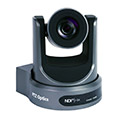All about our Dante-enabled PTZ Camera: The Link 4K
Can you briefly explain what Audinate’s Dante system is and how its recent update to support video is a game-changer in the industry?
Dante stands for ‘Digital Audio Network Through Ethernet,’ and it’s essentially a combination of software, hardware, and network protocols that deliver uncompressed, multi-channel, low-latency digital audio over a standard Ethernet network. It’s become an industry standard for digitally transporting audio because of its ability to synchronize and distribute lossless audio data with very low latency.
Now, the game-changer here is that Dante has extended its capabilities to support video. This is a massive leap because, traditionally, audio and video require separate transport mechanisms, often resulting in issues like unsynchronized audio and video streams or increased complexity in setup and operation. With Dante now supporting video, users can streamline their AV systems even further by having a unified network infrastructure. It reduces both the cost and complexity, making it easier to install, manage, and scale AV systems.
So, in a nutshell, Dante’s support for video amplifies its already powerful ecosystem by offering an all-in-one solution for audio and video over IP, making it an even more robust and versatile platform for AV professionals.

How does the Dante system integrate with the PTZOptics Link 4K camera? Are there any special features that users should be aware of?
The integration of Dante with the PTZOptics Link 4K camera opens up a realm of possibilities for seamless audio and video performance. The PTZOptics Link 4K camera, as many of you might know, offers exceptional 4K video quality, PTZ capabilities, and versatile connectivity options. Now, when you bring Dante into the mix, you’re looking at a more unified, efficient, and powerful AV setup.
One of the key advantages of this integration is streamlined connectivity. You can connect the PTZOptics Link 4K camera to the Dante network using a single Ethernet cable, which can handle both video and multi-channel audio. This simplifies the installation process and minimizes cable clutter, making it an ideal choice for setups where space or aesthetics are a concern.
Another exciting feature is the centralized control. Both the Dante system and PTZOptics camera can be managed from the Dante Controller, allowing users to easily configure and control audio and video settings. For instance, you can synchronize your video with specific audio channels, creating dynamic and engaging live production environment.
The Dante system also allows for scalable solutions. You can easily add more PTZOptics Link 4K cameras or other Dante-enabled devices to the network as your needs grow, without worrying about compatibility or additional hardware.
So, in summary, the integration of Dante with the PTZOptics Link 4K camera offers a more streamlined, flexible, and robust AV setup, making it a compelling choice for professionals in live streaming, broadcasting, and event production.

What are the steps for setting up the Dante system to work with the PTZOptics Link 4K camera? Is the process seamless, or are there challenges users should be prepared for?
Setting up the Dante system to work in conjunction with the PTZOptics Link 4K camera is designed to be a fairly straightforward process, but there are some key steps to follow to ensure seamless operation.
- Initial Setup: First, make sure your PTZOptics Link 4K camera and Dante-enabled audio equipment are connected to the same network. This can usually be done via a standard Ethernet switch.
- Dante Controller Software: Next, you’ll want to install Dante Controller on your computer. This software allows you to configure and manage Dante-enabled devices on your network. Once installed, open the software and you should see your PTZOptics camera and other Dante-enabled devices listed.
- Routing Audio: In Dante Controller, you can set up the audio and video routing. You can assign specific audio channels to be sent to or received from the PTZOptics camera. This is incredibly useful for tasks like synchronizing audio and video or embedding audio into a video feed.
- Video Configuration: On the PTZOptics camera side, you should automatically see the camera in Dante Controller. You have the option to use HD or UHD for Dante Video, this can be configured in the camera WebUI. Also, you can use the Dante Studio software to view the camera video and create a virtual webcam for use with vMix, OBS or Zoom.
- Synchronization: Dante provides options for clock synchronization to ensure that your audio and video are perfectly in sync. You can configure this within the Dante Controller software.
While the process is designed to be user-friendly, it’s always a good idea to read through the documentation for both the PTZOptics camera and the Dante system. Understanding the capabilities and limitations of each can help you troubleshoot any issues that may arise.
So, in essence, while there are a few steps involved, the process is engineered to be as seamless as possible, offering a straightforward way to integrate high-quality audio and video in a unified setup

One common issue in complex setups is audio-video synchronization. How does Dante’s system handle this, especially when integrated with the PTZOptics Link 4K?
Audio-video synchronization is an essential factor in any live production or streaming setup. A mismatch between audio and video can be incredibly distracting and can significantly degrade the viewer’s experience. Fortunately, Dante excels in this area, and its integration with the PTZOptics Link 4K camera offers a robust solution for maintaining perfect sync.
Dante uses Precision Time Protocol, or PTP, to synchronize all devices on the network down to the microsecond level. This ensures that both audio and video streams are aligned in real-time. Because the PTZOptics Link 4K camera is also designed for low-latency performance, the two systems work well together to provide a synchronized AV experience.
In the Dante Controller software, you can designate a master clock source for the network. This could be a dedicated Dante-enabled clock or one of the Dante devices on the network. Once the master clock is set, all other devices on the Dante network will synchronize to it, ensuring that audio and video are delivered in perfect unison.
Another advantage of Dante’s AV sync capabilities is its scalability. Whether you have a small setup with just a PTZOptics camera and a couple of Dante-enabled microphones, or a large-scale production environment with multiple cameras, audio interfaces, and speakers, Dante’s clock synchronization ensures that every component stays in sync.
If you do encounter AV sync issues, troubleshooting is relatively straightforward. The Dante Controller software provides real-time feedback on the synchronization status of each device on the network, making it easier to identify and resolve any problems.
In summary, Dante’s meticulous approach to clock synchronization, combined with the PTZOptics Link 4K camera’s low-latency performance, creates a reliable, synchronized AV environment that’s crucial for professional-grade live streaming and production
Can you provide examples of real-world applications where the Dante system with video support would excel when used alongside the PTZOptics Link 4K camera? For instance, in live event production or remote broadcasting.
Live Event Production: Whether it’s a concert, conference, or theatrical performance, the need for synchronized, high-quality audio and video is paramount. Dante’s unified AV-over-IP network can handle multiple camera angles, audio sources, and even audience interaction seamlessly. The PTZOptics Link 4K, with its 4K imaging and PTZ functionality, can capture the event in high resolution from various angles, enriching the viewer experience.
Broadcast Studios: News and television studios require a reliable and synchronized system for live broadcasting. The Dante system ensures that both audio and video are in perfect sync, which is crucial when you’re going live to millions of viewers. The PTZOptics camera’s low-light performance and 4K capabilities make it an excellent choice for studio setups.
Educational Institutions: With the rise of remote learning, educational institutions need a solid AV setup for virtual classrooms. The PTZOptics camera can capture the lecturer in high resolution, while Dante ensures that both the audio and visual elements are synchronized and clear, offering an effective learning experience.
Corporate Video Conferencing: In the corporate world, video conferencing is an essential part of daily operations. This setup allows for high-quality video and audio streams for remote meetings, presentations, and collaborations. The PTZ functionality of the PTZOptics camera can even allow for room scans, focusing on different speakers, or showcasing products during a virtual presentation.
Houses of Worship: For churches, mosques, synagogues, and other religious venues, live-streaming services have become increasingly important. The integration of Dante with PTZOptics ensures a high-quality, synchronized broadcast, whether it’s just a single camera or a multi-camera setup.


















